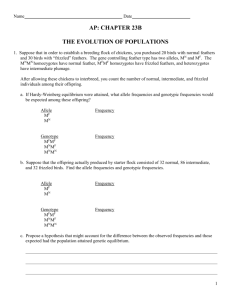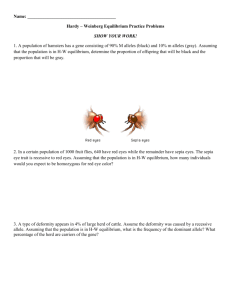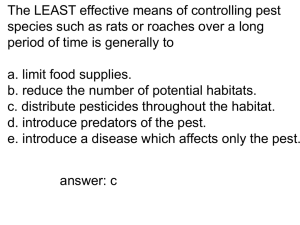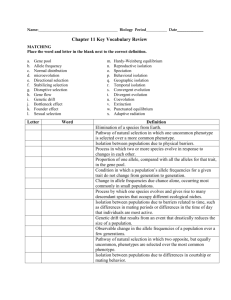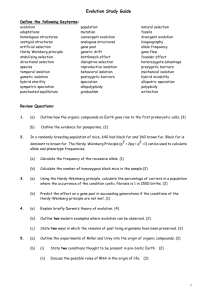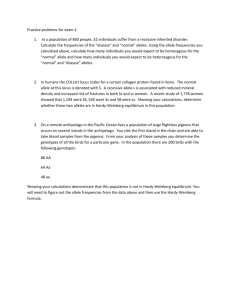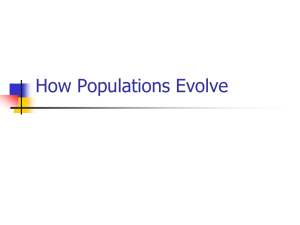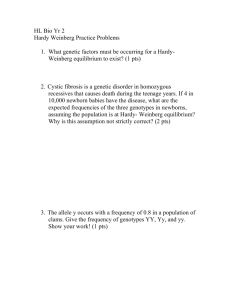The different species of finches on the Galapagos Islands are
advertisement
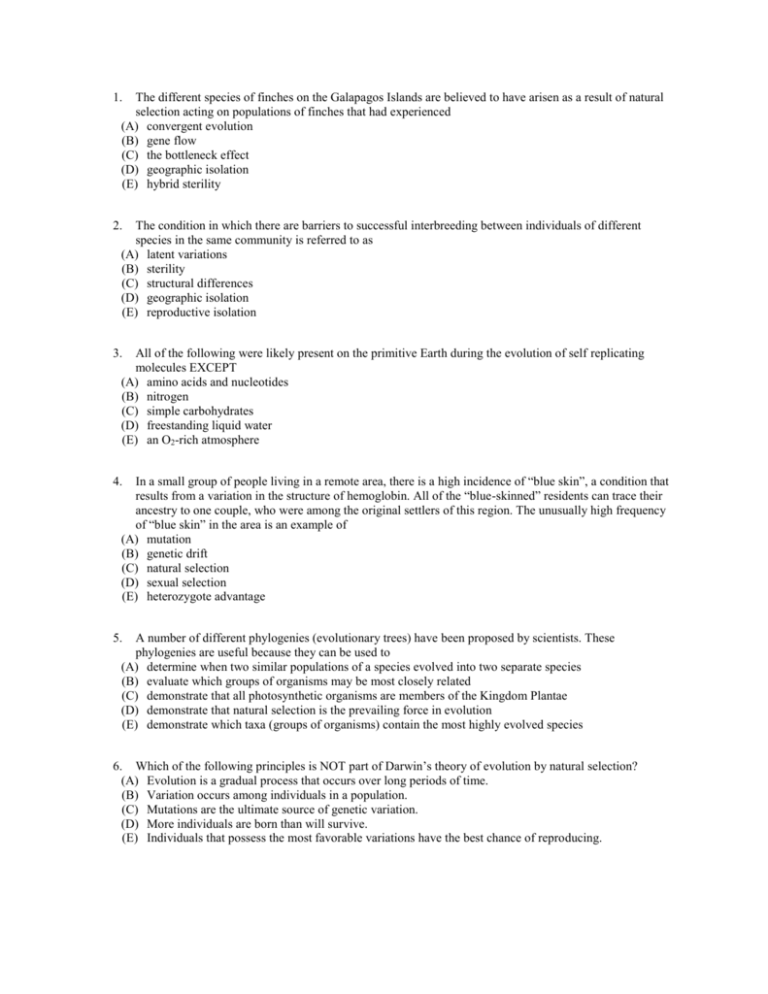
1. The different species of finches on the Galapagos Islands are believed to have arisen as a result of natural selection acting on populations of finches that had experienced (A) convergent evolution (B) gene flow (C) the bottleneck effect (D) geographic isolation (E) hybrid sterility 2. The condition in which there are barriers to successful interbreeding between individuals of different species in the same community is referred to as (A) latent variations (B) sterility (C) structural differences (D) geographic isolation (E) reproductive isolation 3. All of the following were likely present on the primitive Earth during the evolution of self replicating molecules EXCEPT (A) amino acids and nucleotides (B) nitrogen (C) simple carbohydrates (D) freestanding liquid water (E) an O2-rich atmosphere In a small group of people living in a remote area, there is a high incidence of “blue skin”, a condition that results from a variation in the structure of hemoglobin. All of the “blue-skinned” residents can trace their ancestry to one couple, who were among the original settlers of this region. The unusually high frequency of “blue skin” in the area is an example of (A) mutation (B) genetic drift (C) natural selection (D) sexual selection (E) heterozygote advantage 4. 5. A number of different phylogenies (evolutionary trees) have been proposed by scientists. These phylogenies are useful because they can be used to (A) determine when two similar populations of a species evolved into two separate species (B) evaluate which groups of organisms may be most closely related (C) demonstrate that all photosynthetic organisms are members of the Kingdom Plantae (D) demonstrate that natural selection is the prevailing force in evolution (E) demonstrate which taxa (groups of organisms) contain the most highly evolved species 6. Which of the following principles is NOT part of Darwin’s theory of evolution by natural selection? (A) Evolution is a gradual process that occurs over long periods of time. (B) Variation occurs among individuals in a population. (C) Mutations are the ultimate source of genetic variation. (D) More individuals are born than will survive. (E) Individuals that possess the most favorable variations have the best chance of reproducing. 7. In certain Native American groups, albinism due to a homozygous recessive condition in the biochemical pathway for melanin is sometimes seen. If the frequency of the allele for this condition is 0.06, which of the following is closest to the frequency of the dominant allele in this population? (Assume that the population is in Hardy-Weinberg equilibrium.) (A) 0.04 (B) 0.06 (C) 0.16 (D) 0.36 (E) 0.94 8. The wing of a bat, the flipper of a whale, and the forelimb of a horse appear very different, yet detailed studies reveal the presence of the same basic bone pattern. These structures are examples of (A) analogous structures (B) homologous structures (C) vestigial structures (D) balanced polymorphism (E) convergent evolution 9. The carbon 'that makes up organic molecules in plants is derived directly from (A) combustion of fuels (B) carbon fixed in photosynthesis (C) carbon dioxide produced in respiration (D) carbon in the lithosphere (E) coal mines 10. Which of the following is a correct statement about mutations? (A) They are a source of variation for evolution. (B) They drive evolution by creating mutation pressures. (C) They are irreversible. (D) They occur in germ cells but not in somatic cells. (E) They are most often beneficial to the organisms in which they occur. 11. Although the seal and the penguin both have streamlined, fishlike bodies with a layer of insulating fat, they are not closely related. This similarity results from (A) convergent evolution (B) adaptive radiation (C) homologous evolution (D) coevolution (E) parallel evolution 12. Which of the following is probably the best explanation for the fact that Antarctic penguins cannot fly, although there is evidence that millions of years ago their ancestors could do so? (A) Penguins live on land and feed in the water; therefore they have no need to fly. (B) The Antarctic home of penguins is flat and barren; therefore there is no place to fly. (C) Ancestral penguins without large wings were better able to swim and feed in the water; therefore they passed their genes for shorter wing structure on to their offspring. (D) Ancestral penguins did not use their wings for long periods of time; therefore today's penguins have only tiny, nonfunctional wings. (E) The cold and wind of Antarctica make flight impossible; therefore penguins that live there have lost the ability to fly. Questions 13-14. In a certain flock of sheep, 4 percent of the population has black wool and 96 percent has white wool. Assume that the population is in Hardy-Weinberg equilibrium. 13. If black wool is a recessive trait, what percentage of the population is heterozygous for this trait? (A) 4% (B) 20% (C) 32% (D) 64% (E) 80% 14. What percentage of the population is homozygous for white wool? (A) (B) (C) (D) (E) 20% 40% 64% 80% 96% 15. The bones of a human arm are homologous to structures in all of the following EXCEPT a (A) (B) (C) (D) (E) whale flipper bat wing butterfly wing bird wing frog forelimb 16. Competition for food would probably be most severe between two (A) closely related species in different niches (B) closely related species in similar niches (C) unrelated species in different communities (D) unrelated species in the same community occupying different niches (E) ecological equivalents in different niches 17. Some varieties of Neisseria gonorrhoeae are now resistant to penicillin. These varieties of bacteria most probably developed as a result of (A) natural selection (B) hybrid vigor (C) coevolution (D) adaptive radiation (E) convergent evolution 18. The differences in cricket calls among sympatric species of crickets are examples of (A) habitat isolation (B) temporal isolation (C) physiological isolation (D) behavioral isolation (E) geographic isolation 19. In a population that is in Hardy-Weinberg equilibrium, the frequency of a recessive allele for a certain hereditary trait is 0.20. What percentage of the individuals in the next generation would be expected to show the dominant trait? (A) 8% (B) 16% (C) 32% (D) 64% (E) 96% 20. Which of the following statements best describes the effect of genetic drift on the gene frequencies of a population? (A) Genes enter a population through immigration, thus changing gene frequencies. (B) Genes leave a population through emigration, thus changing gene frequencies. (C) Chance alone can cause significant changes in gene frequencies of small populations. (D) Mutations over time cause gene frequencies to change. (E) Selection against one allele causes gene frequencies to change. Directions: The questions below consists of five lettered headings followed by a list of numbered phrases or sentences. For each numbered phrase or sentence select the one heading that is most closely related to it and fill in the corresponding space on the answer sheet. Each heading may be used once, more than once, or not at all in each group. (A) Comparative biochemistry (B) Comparative anatomy (C) Comparative embryology (D) Geographical distribution (E) Paleontology From the fields of study listed above, choose the field that has provided each of the following pieces of evidence that biological evolution has occurred. 21. 22. 23. 24. Archaeopteryx is an extinct feathered reptile Peripatus has claws like an insect and paired nephridia like a segmented worm. Most human diabetics can use insulin derived either from pigs or from humans. During early development, a human fetus has a tail and gill arches. Directions: The group of questions below concerns an experimental or laboratory situation or data. In each case, first study the description of the situation or data. Then choose the one best answer to each question following it and fill in the corresponding space on the answer sheet. A moth's color is controlled by two alleles, G and g, at a single locus. G (gray) is dominant to g (white). A large population of moths was studied, and the frequency of the G allele in the population over time was documented, as shown in the figure below. In 1980, a random sample of 2,000 pupae was collected and moths were allowed to emerge. 25. During which of the following time periods could the population have been in Hardy-Weinberg equilibrium for the G locus? I. 1960-1964 II. 1965-1972 III. 1973-1980 (A) (B) (C) (D) (E) 26. 27. I only II only III only I and III only I, II, and III Assuming that the population was in Hardy-Weinberg equilibrium for the G locus, what percentage of moths in the natural population was white in 1962? (A) 2% (B) 4% (C) 8% (D) 20% (E) 64% Assuming that the population was in Hardy-Weinberg equilibrium for the G locus, what percentage of the gray moths that emerged in 1980 was heterozygous? (A) 0% (B) 25% (C) 33% (D) 67% (E) 100% 28. Assuming that the population was in Hardy-Weinberg equilibrium for the G locus, what was the frequency of allele G in the gray moths that emerged in 1980? (A) 0.33 (B) 0.50 (C) 0.67 (D) 0.75 (E) 1.00 29. Which of the following is the most likely reason for the observed differences in the frequency of the G allele between 1965 and 1972? (A) Emigration of white moths from the population (B) Chance (C) Selection against gray phenotypes (D) Speciation (E) Mutation
